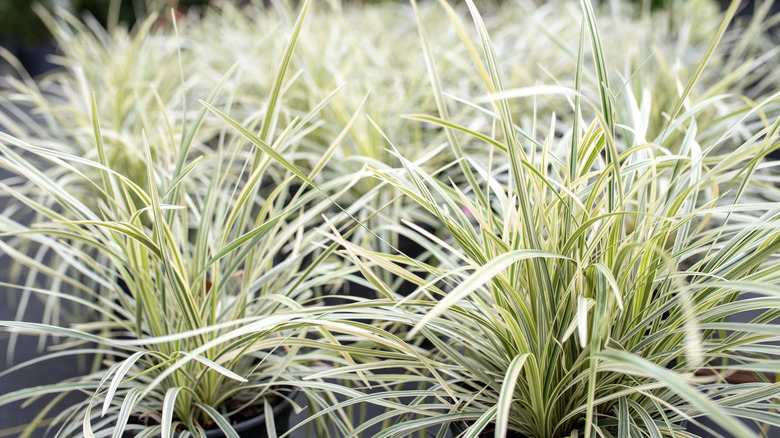Save Money On A Popular Garden-Border With This Gardening Tip
Bordering our gardens is a satisfying endeavor that leaves our outdoor spaces clean-cut and pristine. However, implementing these borders isn't necessarily cheap, and professional landscape edging can cost well over $700 based on labor and materials used. Even if you forgo professional help and DIY it with some mulch and stone, costs add up quickly. If you want to save money, it's wise to seek out less conventional options that may not feature intricate rocks and colorful mulch but will be no less attractive. Aztec grass is not the most common way to border our gardens, but it's still used frequently and for good reason — it's easy to split, meaning it can be divided and used to make more borders as necessary.
Also known as Lily Turf and Monkey grass, Aztec grass is a wispy tufted perennial and sports silvery green foliage, often highlighted with white variegation and flowering in peak season. The ornamental grass makes for the perfect garden border with its average size of 15 inches tall and 18 inches wide, growing well in full sun or shade and aerated, moist soils. It's easy to grow and care for, known to be resilient, and adaptable to growing conditions. Retailers like Home Depot sell a 4-pack of Aztec grass for $34.98, here's how to divide it up and get the most out of your plants.
Separating & planting Aztec grass
Not only does dividing your Aztec grass create an affordable way to enhance your garden's border, but it is healthier for the plant in the long run. When left to grow without any intervention for too long, the grass may become feeble and slow its growth. You'll want to avoid propagating during the growing season and definitely not while it is flowering, so towards the end of winter or the start of spring while the grass is dormant will be best. Begin by digging up the plant with a pickaxe or garden shovel, being careful not to damage any roots in the process. Once the grass is out of the ground, simply use a knife to split the plant and separate the roots.
Depending on the size of your Aztec grass, it can be split into three or four sections. You will just want to make sure that each portion has strong and healthy roots to support new solo growth. To avoid the roots drying out, replant the grass immediately after dividing it. When replanting, the crown should line up just below the surface of the soil. You can expect to see the smaller and newly planted portions of Aztec grass begin filling out over the course of spring and summer as the growing season commences.
Caring for Aztec grass
Aztec grass is an incredibly easy perennial to care for, with it being resistant to pests, disease, drought, and even the deer that like to take their lunch and dinner in our yards. This ornamental grass is not particular about the soil type or pH levels it is planted in but prefers to be kept moist and well-aerated. Although Aztec grass is tolerant to drought, it will not survive sitting in standing water. Drainage will be critical when growing this grass in your garden.
Before peak growing season arrives in the spring, Aztec grass can benefit from a slow-release fertilizer and some trimming to encourage new growth. You can plant it in bright and sunny spots, and it will adapt and still have a healthy life, but it will do best in at least partial shade. You can expect your Aztec grass to live up to 10 years in your garden when grown with the proper tenderness, love, and care.


